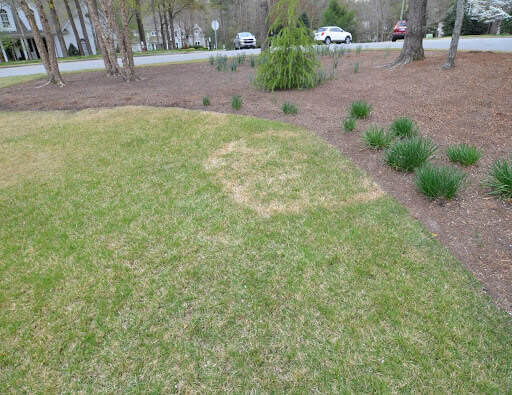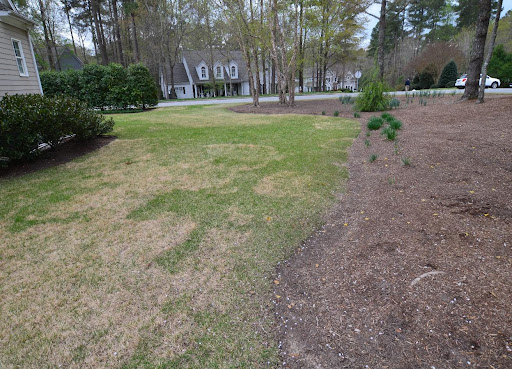We’re covering spring-specific tips and tricks for getting your lawn in seasonal shape!


Spring is when conditions are often most favorable for moss development, including excess shade and moisture. Conditions that create moss indicate a poor growing environment for quality turf (like poor draining/compacted soil not being able to dry properly). While moss does not generally kill grass, it can take over areas where turf is thin or unable to grow properly.
As moss is a non-vascular plant, regular weed controls can’t help deal with it. There is also no reasonable chemical control option to remove moss either. Ultimately, controlling moss comes down to eliminating the conditions that create it. For the best preventive measures and direct actions you can take, check out our blog.


Poa annua (annual Bluegrass) usually stands out from late April to May. This is due to the large amount of tan-colored seed heads the plant produces during this time. However, above-average ground temperatures mean seed heads may have already started appearing.
As a wild annual grass, Poa annua can show up anywhere and acts very similarly to a weed. Its hardiness means it can grow in poor conditions where desirable turf will not, like areas that have poor/compacted soil, but you may even find it in the middle of your yard.
Common areas it shows up include:
Poa annua germination started in late August and went through the winter, and because of its maturity during pre-emergent Crabgrass applications in January, February and early spring, it’s not controlled by them. It will generally end its life cycle in late May and June, but as a prolific seeder, new plants can pop up next year.
We can control about 70-85% percent of Poa annua through split application treatments in November and December. As we’re already outside the window for these applications, the best control at this point is to maintain good quality turf and density. Please contact us or visit here to find out what services we can offer to help your specific lawn.


Large patch fungus is a harmful disease for zoysia, Bermuda, centipede and St. Augustine turfs in the fall and early spring. Similar to brown patch fungus on fescue, we’re seeing more cases of this disease every year in our area. Damage occurs before you can even be aware of it and will not be visible until green-up in the spring.
Controlling large patch fungus requires two applications of preventative fungicide in the spring and fall, or when ground temperatures are between 50 and 70 degrees. This is the only real way to handle it.
Centipede and St. Augustine are most likely to be affected with winter damage this year (both have very little cold tolerance) but Bermuda and zoysia can also be damaged. Most of the injury/damage likely occurred around the week of December 25th. This is when North Carolina, and some of South Carolina, had three straight nights in the low teens and two days at or below freezing.
You’ll usually know if your warm-season lawn received winter damage by the end of May. In the transition zone, which a large portion of NC is in, warm-season turf generally won’t start growing until this time (when ground temperatures start being ideal for 24-hour plant growth and activity). This gives us the best idea of potential warm-season turf injuries.
Of course, some lawns will look green or somewhat green before this time. Several new varieties of Bermuda and zoysia break dormancy earlier and stay active longer into the fall. Centipede may also try to break dormancy earlier than this and can get damaged by spring cold spells. However, in most cases, these turfs will not be actively growing yet.
If you are really concerned about a part of the lawn that just isn’t looking right, here’s what you can do:
A common misconception is that broadleaf weeds like chickweed and clover should turn brown and die within a couple of days of treatment. However, this is often not the case, as most can take a couple of weeks to show signs of control. In fact, even if it’s under control, a broadleaf weed may still not turn brown. More often than not, it will suddenly just start to shrivel up and disappear, leaving behind a very small skeleton.